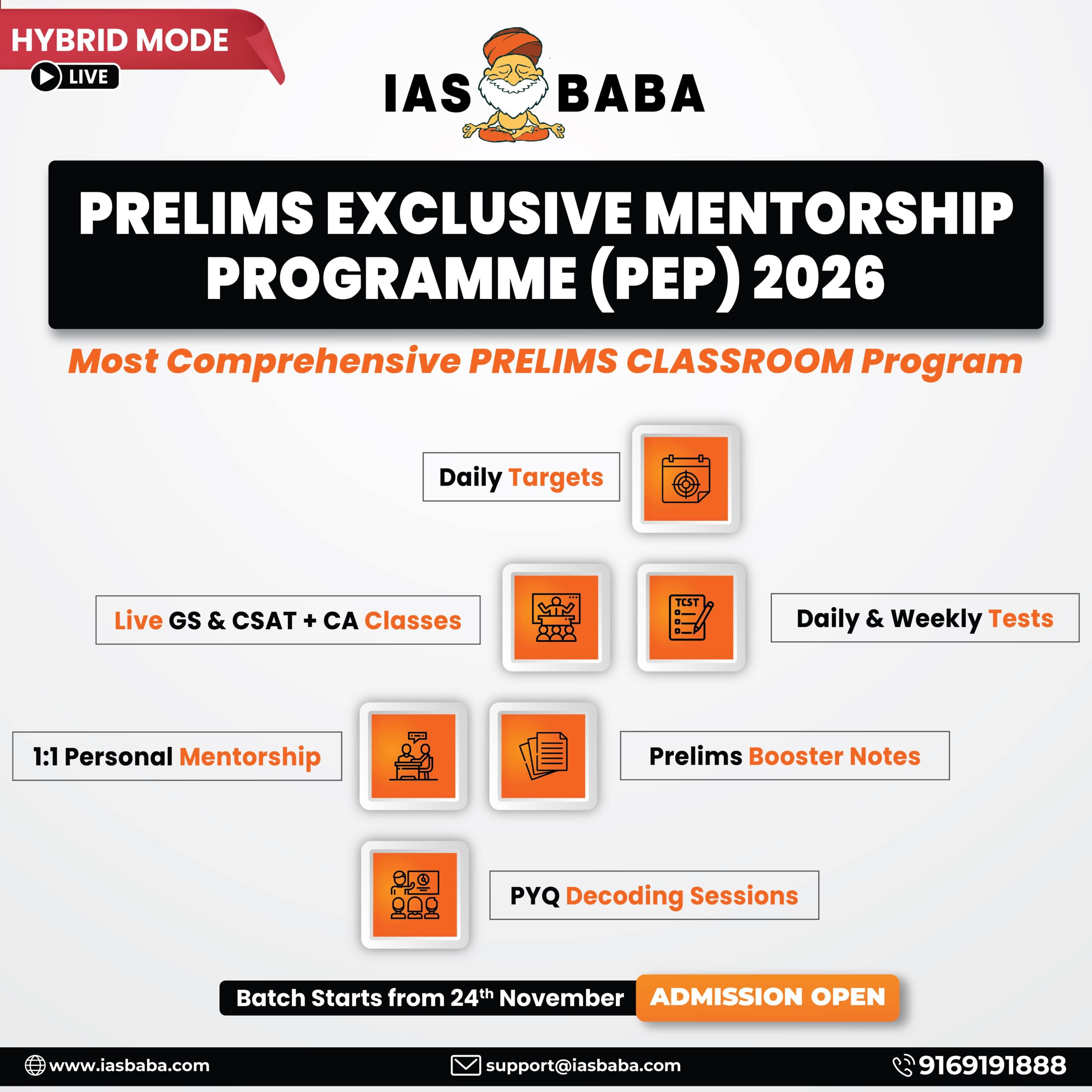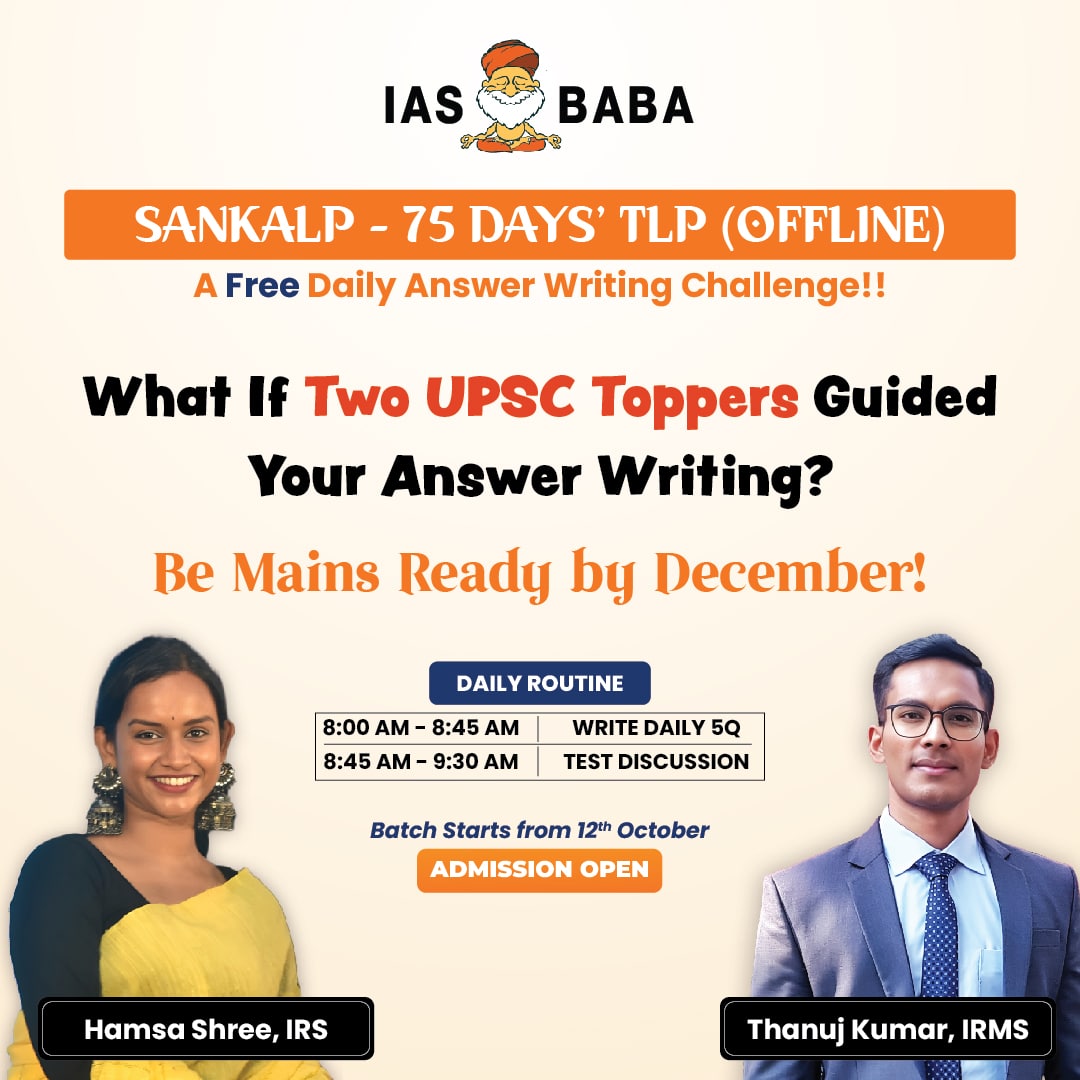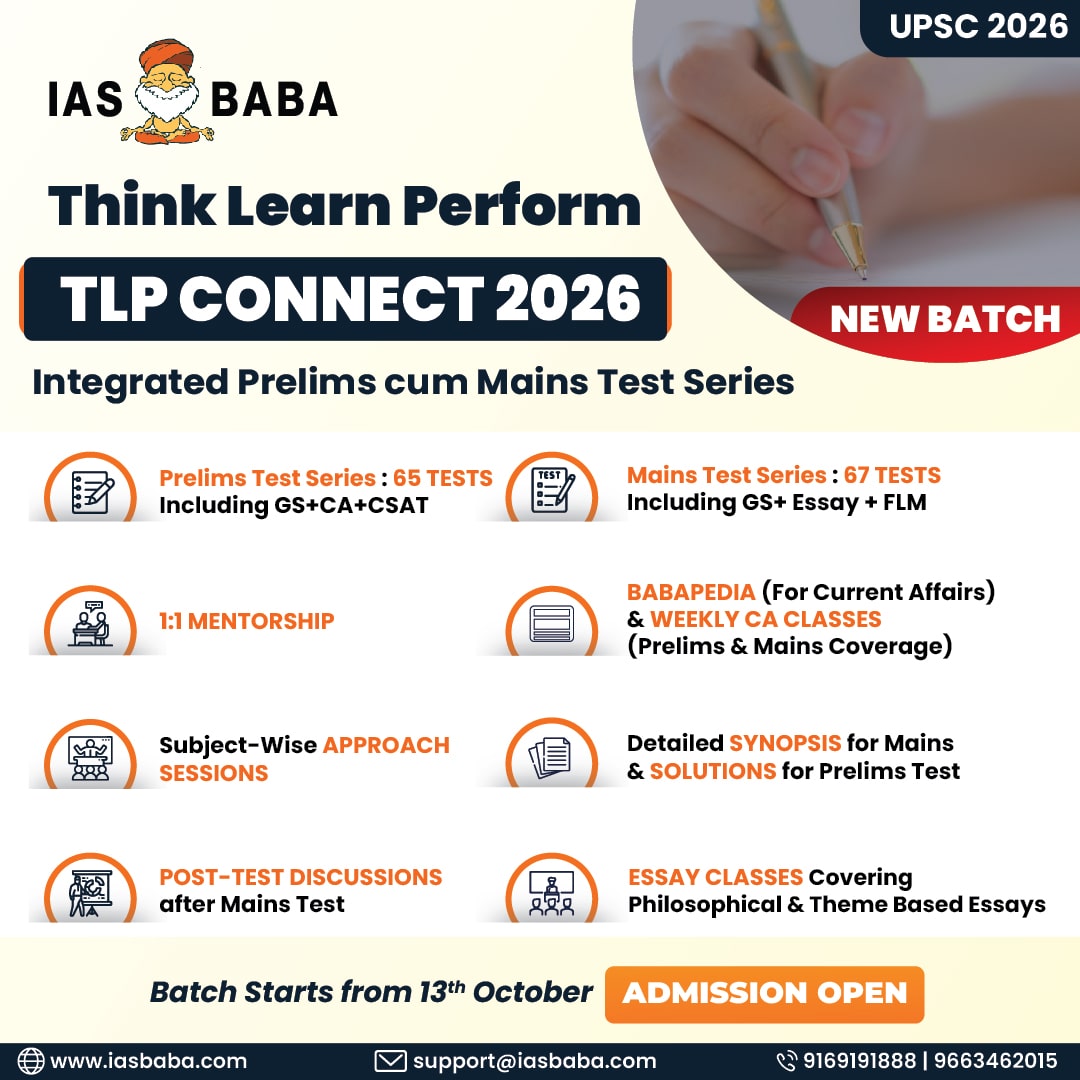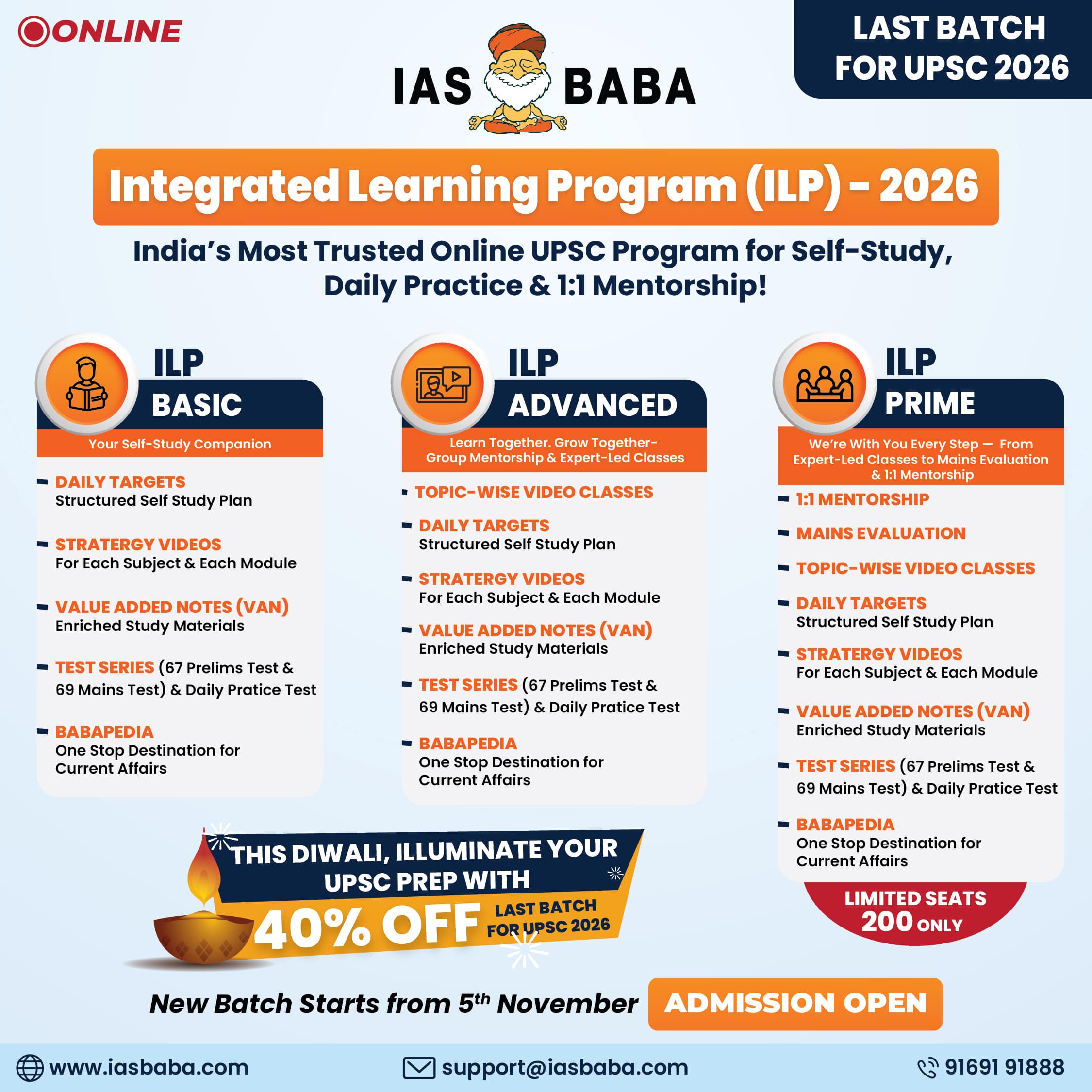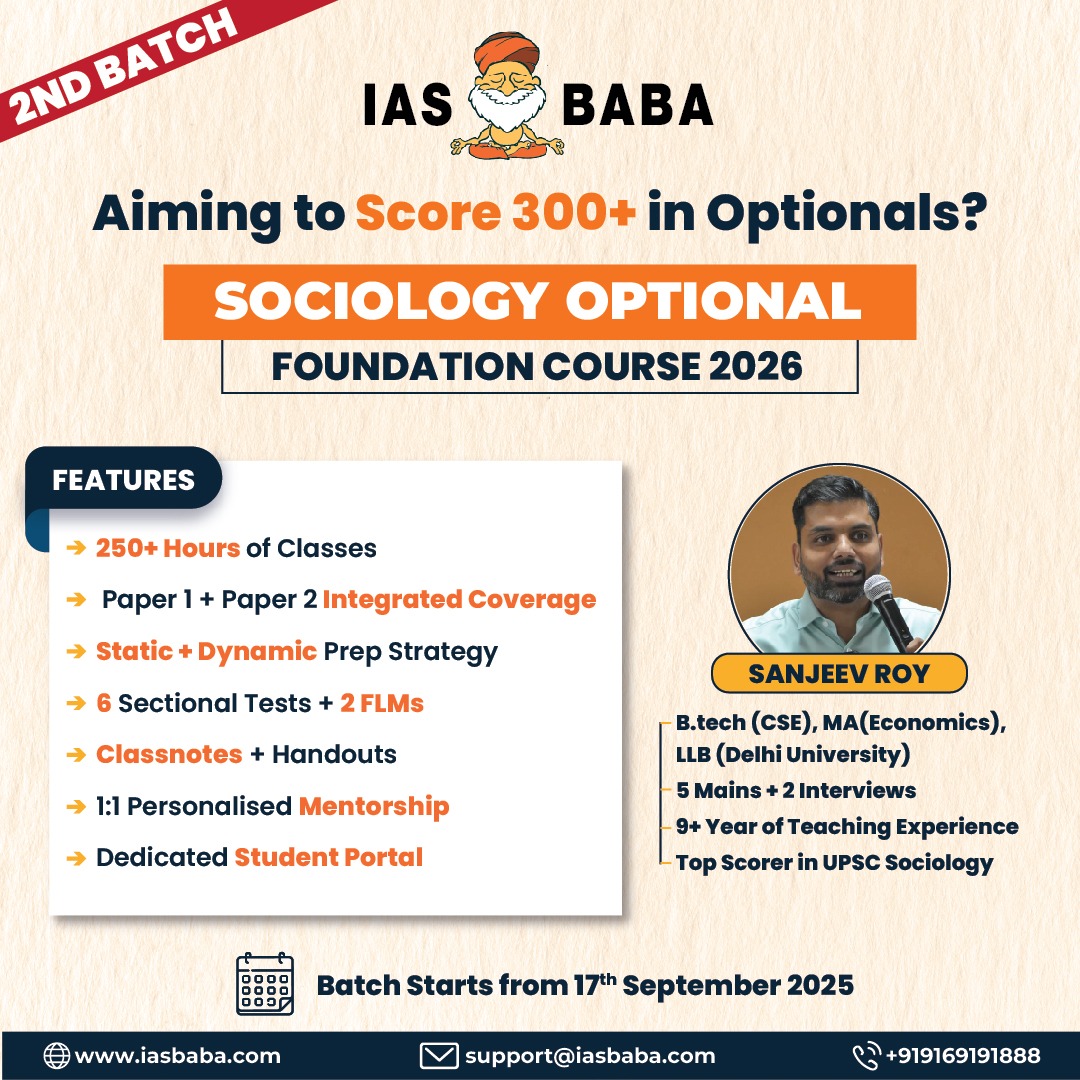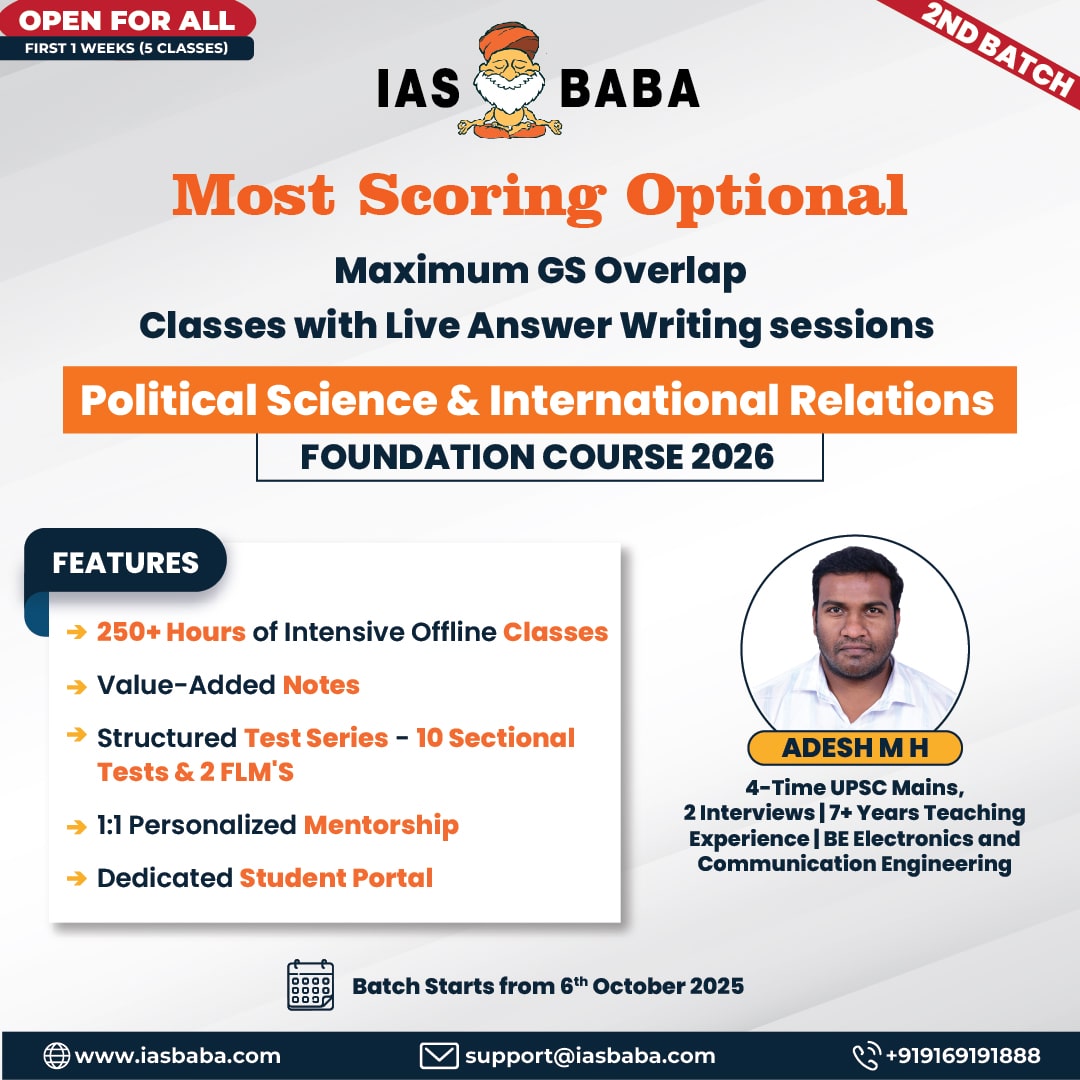IASbaba Daily Prelims Quiz
For Previous Daily Quiz (ARCHIVES) – CLICK HERE
The Current Affairs questions are based on sources like ‘The Hindu’, ‘Indian Express’ and ‘PIB’, which are very important sources for UPSC Prelims Exam. The questions are focused on both the concepts and facts. The topics covered here are generally different from what is being covered under ‘Daily Current Affairs/Daily News Analysis (DNA) and Daily Static Quiz’ to avoid duplication. The questions would be published from Monday to Saturday before 2 PM. One should not spend more than 10 minutes on this initiative.
Gear up and Make the Best Use of this initiative.
Do remember that, “the difference between Ordinary and EXTRA-Ordinary is PRACTICE!!”
Important Note:
- Don’t forget to post your marks in the comment section. Also, let us know if you enjoyed today’s test 🙂
- After completing the 5 questions, click on ‘View Questions’ to check your score, time taken, and solutions.
Test-summary
0 of 5 questions completed
Questions:
- 1
- 2
- 3
- 4
- 5
Information
To view Solutions, follow these instructions:
- Click on – ‘Start Test’ button
- Solve Questions
- Click on ‘Test Summary’ button
- Click on ‘Finish Test’ button
- Now click on ‘View Questions’ button – here you will see solutions and links.
You have already completed the test before. Hence you can not start it again.
Test is loading...
You must sign in or sign up to start the test.
You have to finish following test, to start this test:
Results
0 of 5 questions answered correctly
Your time:
Time has elapsed
You have scored 0 points out of 0 points, (0)
| Average score |
|
| Your score |
|
Categories
- Not categorized 0%
| Pos. | Name | Entered on | Points | Result |
|---|---|---|---|---|
| Table is loading | ||||
| No data available | ||||
- 1
- 2
- 3
- 4
- 5
- Answered
- Review
-
Question 1 of 5
1. Question
The red ivy plant (Strobilanthes alternata), recently in news, is traditionally used for which of the following purposes?
Correct
-
Solution: (b)
Explanation:
- (Strobilanthes alternata), locally called murikooti pacha, is traditionally applied on cuts and wounds in Kerala.
- It contains acteoside, a bioactive compound with antimicrobial and healing properties.
Incorrect
-
Solution: (b)
Explanation:
- (Strobilanthes alternata), locally called murikooti pacha, is traditionally applied on cuts and wounds in Kerala.
- It contains acteoside, a bioactive compound with antimicrobial and healing properties.
-
Question 2 of 5
2. Question
In the context of mosquito-borne diseases, the term Wolbachia recently seen in news refers to:
Correct
-
Solution: (a)
Explanation:
- Wolbachia is a naturally occurring bacterium introduced into Aedes mosquitoes.
- It limits replication of viruses like dengue, Zika, and chikungunya inside the mosquito, thereby reducing disease transmission.
What is Wolbachia and how it works for disease control
- Wolbachia pipientis is a naturally occurring intracellular bacterium present in many insect species—but not originally in Aedes aegypti, the main mosquito vector for dengue, Zika, chikungunya, yellow fever.
- Scientists infect Aedes aegypti mosquitoes with Wolbachia in laboratory settings and then release them into the wild. These Wolbachia-carrying mosquitoes breed with the wild population. Over generations, the proportion of mosquitoes carrying Wolbachia rises. Once sufficiently established, most mosquitoes in that locality carry the bacterium.
- Two key effects help reduce transmission of viruses:
- Virus-blocking: Wolbachia interferes with the ability of viruses (dengue, Zika etc.) to replicate and/or spread inside the mosquito, reducing viral load and infectivity.
- Cytoplasmic incompatibility: A reproductive phenomenon – if a Wolbachia-infected male mates with an uninfected female, the eggs fail to develop. In contrast, infected females produce infected offspring whether mating with infected or uninfected males. This gives a reproductive advantage to the Wolbachia‐infected females, helping the infection spread through the mosquito population.
- This method is not genetic modification. It is self-sustaining once Wolbachia becomes widespread in mosquito population.
- Real-world trials (e.g., in Yogyakarta, Indonesia) show large reductions in dengue incidence and hospitalisations in areas where Wolbachia-infected mosquitoes have been released.
- Considerations include: establishing Wolbachia at high enough frequency to be self-sustaining, monitoring for any evolution of virus or mosquito that may reduce effectiveness, and ensuring community acceptance.
Incorrect
-
Solution: (a)
Explanation:
- Wolbachia is a naturally occurring bacterium introduced into Aedes mosquitoes.
- It limits replication of viruses like dengue, Zika, and chikungunya inside the mosquito, thereby reducing disease transmission.
What is Wolbachia and how it works for disease control
- Wolbachia pipientis is a naturally occurring intracellular bacterium present in many insect species—but not originally in Aedes aegypti, the main mosquito vector for dengue, Zika, chikungunya, yellow fever.
- Scientists infect Aedes aegypti mosquitoes with Wolbachia in laboratory settings and then release them into the wild. These Wolbachia-carrying mosquitoes breed with the wild population. Over generations, the proportion of mosquitoes carrying Wolbachia rises. Once sufficiently established, most mosquitoes in that locality carry the bacterium.
- Two key effects help reduce transmission of viruses:
- Virus-blocking: Wolbachia interferes with the ability of viruses (dengue, Zika etc.) to replicate and/or spread inside the mosquito, reducing viral load and infectivity.
- Cytoplasmic incompatibility: A reproductive phenomenon – if a Wolbachia-infected male mates with an uninfected female, the eggs fail to develop. In contrast, infected females produce infected offspring whether mating with infected or uninfected males. This gives a reproductive advantage to the Wolbachia‐infected females, helping the infection spread through the mosquito population.
- This method is not genetic modification. It is self-sustaining once Wolbachia becomes widespread in mosquito population.
- Real-world trials (e.g., in Yogyakarta, Indonesia) show large reductions in dengue incidence and hospitalisations in areas where Wolbachia-infected mosquitoes have been released.
- Considerations include: establishing Wolbachia at high enough frequency to be self-sustaining, monitoring for any evolution of virus or mosquito that may reduce effectiveness, and ensuring community acceptance.
-
Question 3 of 5
3. Question
-
With reference to the philosophical and socio-political thought of Swami Vivekananda, consider the following statements:
-
He upheld the Advaita Vedanta philosophy but simultaneously emphasized its practical application through service to humanity.
-
His idea of nationalism was rooted in the spiritual regeneration of India rather than political agitation.
-
He regarded education as the manifestation of perfection already present in man, linking it with both individual self-realization and national progress.
How many of the above statements are correct?
Correct
-
Solution: (c)
Explanation:
- Statement 1: While drawing from Advaita Vedanta, Vivekananda stressed practical Vedanta, teaching that service to man is service to God. Hence the statement is Correct
- Statement 2: He envisioned nationalism as spiritual awakening and social reform, inspiring Indians with self-confidence and cultural pride, not mere political struggle. Hence the statement is Correct
Statement 3: He defined education as “the manifestation of perfection already in man”, highlighting its transformative role for both individuals and the nation. Hence the statement is Correct
Incorrect
-
Solution: (c)
Explanation:
- Statement 1: While drawing from Advaita Vedanta, Vivekananda stressed practical Vedanta, teaching that service to man is service to God. Hence the statement is Correct
- Statement 2: He envisioned nationalism as spiritual awakening and social reform, inspiring Indians with self-confidence and cultural pride, not mere political struggle. Hence the statement is Correct
Statement 3: He defined education as “the manifestation of perfection already in man”, highlighting its transformative role for both individuals and the nation. Hence the statement is Correct
-
-
Question 4 of 5
4. Question
-
Consider the following statements regarding NASA’s Perseverance rover:
-
It landed in Jezero Crater, a site believed to have hosted an ancient river delta.
-
It is equipped with instruments to search for biosignatures and also collects samples for a planned Mars Sample Return mission.
-
It carried the first helicopter, Ingenuity, which successfully demonstrated powered flight on another planet.
Which of the above statements are correct?
Correct
-
Solution: (d)
Explanation:
- Statement 1: Perseverance landed in Jezero Crater in February 2021, chosen for its ancient river delta deposits. Hence the statement is Correct
- Statement 2: Its mission includes astrobiology research, searching for past life signs, and caching samples for future return. Hence the statement is Correct
- Statement 3: It carried Ingenuity, the first rotorcraft on Mars, which achieved controlled flight beyond Earth. Hence the statement is Correct
Incorrect
-
Solution: (d)
Explanation:
- Statement 1: Perseverance landed in Jezero Crater in February 2021, chosen for its ancient river delta deposits. Hence the statement is Correct
- Statement 2: Its mission includes astrobiology research, searching for past life signs, and caching samples for future return. Hence the statement is Correct
- Statement 3: It carried Ingenuity, the first rotorcraft on Mars, which achieved controlled flight beyond Earth. Hence the statement is Correct
-
-
Question 5 of 5
5. Question
-
-
Consider the following islands in the Indian Ocean region:
-
Mauritius
-
Seychelles
-
Comoros
-
Reunion
-
Maldives
With reference to the locations of island nations in the Indian Ocean, consider the following statements
-
All lie to the east of the African mainland.
-
All are located south of the Equator.
-
Maldives lies north of Mauritius.
Which of the above statements about their location is/are correct?
-
Correct
-
Solution: (b)
Explanation:
- Statement 1: All five islands lie to the east of mainland Africa. Hence the statement is Correct
- Statement 2: Seychelles and Maldives are north of the Equator; Mauritius, Reunion, and Comoros are south. Hence the statement is Incorrect
Statement 3: Maldives lies north of Mauritius, making it tricky for candidates who only consider “Indian Ocean islands south of India.” Hence the statement is Correct
Incorrect
-
Solution: (b)
Explanation:
- Statement 1: All five islands lie to the east of mainland Africa. Hence the statement is Correct
- Statement 2: Seychelles and Maldives are north of the Equator; Mauritius, Reunion, and Comoros are south. Hence the statement is Incorrect
Statement 3: Maldives lies north of Mauritius, making it tricky for candidates who only consider “Indian Ocean islands south of India.” Hence the statement is Correct
-
- Current Affairs Quiz, IAS Daily Current Affairs Quiz, IAS UPSC Current Affairs Quiz, IAS UPSC Prelims Quiz, IASbaba's Current Affairs Prelims Quiz, IASbaba's Daily Quiz, IASbaba's UPSC Quiz, Prelims Current Affairs Quiz, UPSC Current Affairs Quiz, UPSC Current Affairs Quiz IASbaba, UPSC Daily Current Affair Quiz, UPSC IAS Daily Quiz



